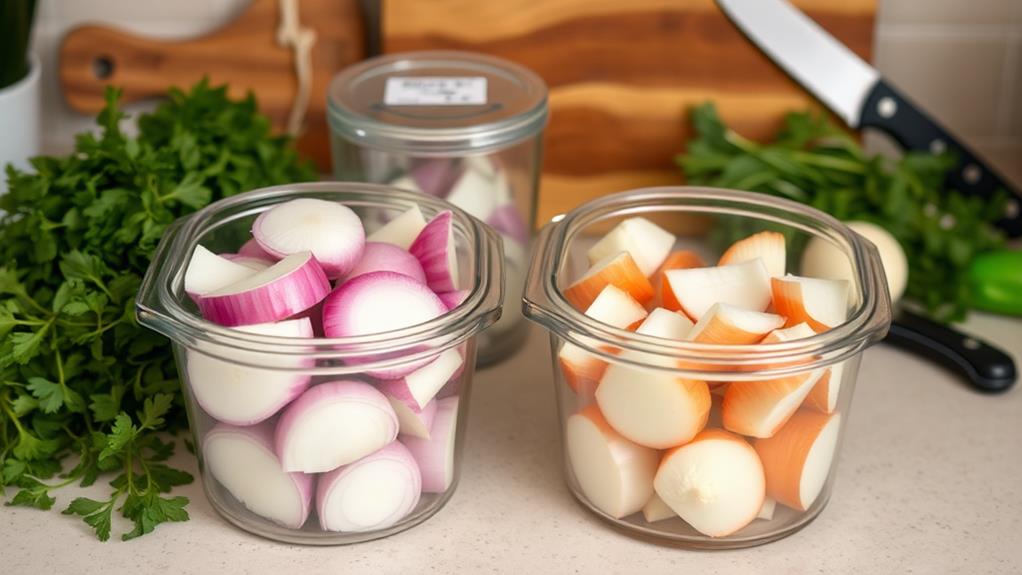To prevent waste and save money, store cut onions in the fridge immediately. Use airtight containers or plastic wrap to keep odors at bay. Make sure they're in the crisper drawer at or below 40°F (4°C) and check them for spoilage regularly. If you want to extend their life, freeze chopped onions in ½ inch cubes, spreading them out first to avoid clumping. Label containers with dates for tracking. Remember to use stored onions in your meals just like fresh ones. There are even more handy tips out there that can help you keep your onions fresh longer.
Storing Cut Onions in the Refrigerator
When it comes to storing cut onions in the refrigerator, you should refrigerate them immediately to maintain their freshness. To do this effectively, place your cut onions in an airtight container or wrap them tightly in plastic wrap. This helps keep them fresh for about 7-10 days.
To prevent odor absorption, consider using glass containers or specially designed onion-saver containers, and always keep them away from strong-smelling foods. Utilizing efficient storage methods can also help reduce kitchen waste, similar to how expense management apps streamline financial organization.
Make sure to store your cut onions in the crisper drawer of your fridge at or below 40°F (4°C). This keeps bacterial growth at bay and extends their shelf life.
Regularly check your stored cut onions for signs of spoilage, such as cloudiness, mushiness, or unusual odors, before using them. If you notice any dried or slimy pieces, remove them to enhance the overall freshness and flavor of your onions.
Freezing Cut Onions for Longevity
Freezing cut onions is a fantastic way to preserve their flavor and extend their shelf life. Chopped onions can be frozen for up to 8 months while maintaining quality, as long as you store them in freezer-safe airtight bags or containers at or below 0°F (-18°C).
To achieve ideal freezing, start by chopping your onions into small pieces—aim for ½ inch cubes. It's also beneficial to maintain a good routine for checking your stored food items, similar to how you'd manage financial organization strategies.
Spread the chopped onions in a single layer on a baking sheet for 1 hour; this step helps prevent clumping. Once they're frozen, transfer the onions to airtight bags, squeezing out as much air as possible to further protect against freezer burn.
Don't forget to label your containers with the date of storage so you can keep track of freshness. When you're ready to use your stored onions, you can add them directly from the freezer into your recipes without thawing.
This method is especially useful for soups, stews, and casseroles, as it helps retain their texture. By freezing your cut onions, you not only reduce waste but also save money in the long run.
Alternative Preservation Methods

There are several effective ways to preserve cut onions beyond freezing, each offering unique benefits. One method is dehydrating onions, which allows for long-term storage of up to one year. Simply slice them thinly and dehydrate at 130-140°F for 3-9 hours until fully dried, then store in an airtight container.
Additionally, using proper storage methods can help reduce waste and save money over time, similar to how expense tracking tools assist entrepreneurs in managing their finances effectively. You might also consider pickling onions, which can last up to six months when unopened. Use a mixture of apple cider vinegar, sugar, and salt, ensuring proper headspace in your jars.
If you're freezing chopped onions, they'll maintain quality for up to eight months. Chop your fresh onions into smaller pieces, freeze them in a single layer, and then transfer to freezer-safe bags or storage containers, labeling with the date.
Fermenting onions creates a tangy flavor and can be stored for several months using a saltwater brine to keep them submerged.
Lastly, vacuum sealing cut onions before freezing can greatly reduce freezer burn and odor transfer, enhancing their longevity and flavor quality. By exploring these alternative preservation methods, you'll minimize waste and save money effectively.
Cooking With Stored Onions
Cooking with stored onions can be just as rewarding as using fresh ones. When you've properly stored cut onions in an airtight container, they're ready to enhance your dishes. You can sauté, roast, or grill refrigerated onions just like whole onions, though you might notice some flavor variation.
Utilizing AI-driven tools can help you discover new recipes that incorporate stored onions, making your cooking experience even more enjoyable. If you've opted to freeze your onions, you can use them directly from the freezer in soups, stews, and casseroles without thawing. This method not only saves time but also helps you maintain their quality. Just remember to adjust cooking times, as frozen onions may need a bit longer to reach the right texture.
Incorporating stored onions into soft-textured dishes is one of the best ways to store them effectively, as this prevents mushiness. Before you start cooking, always check for signs of spoilage, like unusual odors or textures. This guarantees that your meals remain safe and delicious.
Common Storage Mistakes to Avoid

Many people unintentionally make common mistakes when storing cut onions, which can lead to quicker spoilage and loss of flavor. One major mistake is using plastic containers to store onions. These can trap moisture and odors, causing your cut onions to spoil faster. Instead, opt for an airtight container that can help maintain freshness.
Additionally, just as freelancers benefit from budgeting tools to manage their finances effectively, being mindful of proper onion storage can save you money by preventing waste budget management tools.
Another critical error is leaving cut onions uncovered in the fridge. Exposure to air won't only dry them out but also diminish their flavor. Make sure to seal them properly.
Additionally, avoid placing cut onions near strong-smelling foods, as they can easily absorb those odors, which will affect their taste and quality.
It's also important to remember that you shouldn't store cut onions at room temperature; always refrigerate them immediately to slow bacterial growth.
Finally, if you plan to freeze cut onions, verify they're chopped first, as whole cut onions may not freeze well and can develop an undesirable texture when thawed.
Conclusion
By storing cut onions properly, you're not just keeping your fridge fresh; you're also saving money like a savvy shopper. Imagine vibrant, crisp onions ready to elevate your next meal, instead of wilted, forgotten pieces at the back of the fridge. Whether you choose to refrigerate, freeze, or explore other preservation methods, you're embracing efficiency. So, next time you chop an onion, think of the delicious dishes ahead and the waste you're leaving behind.



